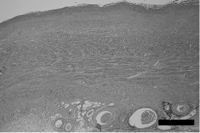-
PDF
- Split View
-
Views
-
Cite
Cite
Shohjiro Yamaguchi, Go Watanabe, Shinichiro Yamamoto, Rapid formation of the left ventricular pseudoaneurysm after sutureless repair of a subacute left ventricular free wall rupture, Interactive CardioVascular and Thoracic Surgery, Volume 5, Issue 4, August 2006, Pages 462–463, https://doi.org/10.1510/icvts.2005.127001
Close - Share Icon Share
Abstract
Objective: We report a rare, rapid, huge formation of the left ventricular pseudoaneurysm after sutureless repair with GRF glue. Methods: The case was a 70-year-old male, who received an emergency operation for a subacute left ventricular free wall rupture (LVFWR) complicated by acute myocardial infarction. At that time the left ventricle was wrapped with equine pericardium by using gelatin resorcin formaldehyde (GRF) glue (sutureless repair). The patient had been stable for 13 months but suffered acute heart failure. The left ventricular angiogram (LVG) revealed a huge left ventricular aneurysm and 75% stenosis in the middle segment of the left anterior descending artery (LAD). He had received the LVG one month before. There was a small concavity in the inferior wall of the left ventricle. A huge pseudoaneurysm had formed within one month. Results: A left ventricle direct patch closure, and coronary artery bypass were performed. In the pathological findings, the wall of the aneurysm was almost elastic collagen tissue. Conclusions: Sutureless repair is an effective technique for subacute left ventricular free wall rupture, a left ventricular pseudoaneurysm has to be cared for the late period.
1. Introduction
Left ventricular free wall rupture is a fatal disease. We performed a sutureless repair with equine pericardium attached by GRF glue for subacute LVFWR, but a huge left ventricular pseudoaneurysm formed rapidly. Direct patch closure was performed for the second operation. Such rapid formation of a left ventricular pseudoaneurysm is very rare.
2. Materials and methods
A 70-year-old male was admitted to hospital with chest pain. The diagnosis was acute myocardial infarction (AMI). A coronary angiogram (CAG) revealed total occlusion in the proximal segment of the left circumflex (Cx) artery and 50% stenosis in the middle segment of the LAD. His systolic blood pressure was approximately 80 mmHg. An echocardiogram revealed massive pericardial effusion. It was diagnosed as LVFWR. We performed an emergency operation. Severe oozing was seen from the inferior free wall of the ventricle. There was no major myocardial tear. We diagnosed as an oozing type rupture. A patch of equine pericardium (7×10 cm) for covering the entire infarcted area was attached to the surface of the heart with the GRF glue with a cardiopulmonary bypass. The postoperative patient's course was stable. He was discharged without any symptoms of heart failure.
Twelve months later, he was admitted to our institute for treatment of a gall stone. During this period, he received a follow-up LVG. A left ventricular pseudoaneurysm was not detected (Fig. 1A ). However, he complained of breathlessness a month after discharge from hospital. The LVG and an echocardiogram revealed a huge aneurysm of the inferior wall (Fig. 1B, C). The CAG revealed total occlusion in the Cx and 75% stenosis in the LAD.

A. One year follow-up LVG revealed only a small concavity in the inferior wall. B. A huge left ventricle pseudoaneurysm formed within a month after follow-up LVG. C. We detected recurrence of LV aneurysm by an echocardiogram at first.
3. Results
A second surgery was performed. Under general anesthesia, a left thoracotomy in the fourth intercostal space and reversed L ministernotomy was made. A cardiopulmonary bypass was established with the femoral vein and artery. Severe adhesion was observed surrounding the heart. The left internal mammary artery (LIMA) was harvested. The aneurysm was incised, and the surface of the left ventricle was observed through the incised area. A small blow-out hall was found in the inferior wall of the heart. Direct patch closure with equine pericardium was performed. Coronary artery bypass grafting to the LAD was performed with LIMA. In pathological findings, the wall of the aneurysm consisted of elastic collagen fiber (Fig. 2 ).

Micrograph of the wall of aneurysm. Elastica van Gieson stain was performed. The wall consisted of elastic collagen fiber. Bar=5 mm.
The patient's postoperative course was uneventful. Post-operative LVG revealed removal of the aneurysm.
4. Discussion
LVFWR is a fatal, catastrophic disease because of cardiac tamponade. It will occur about 3% in AMI [1]. Sutureless repair is said to be effective for subacute LVFWR [2]. This procedure can be performed without a cardiopulmonary bypass and keep the left ventricular geometry. So it will reduce the time for hemostasis, and avoid postoperative low output syndrome. Noda and coworkers reported that GRF glue made tight adhesion between the myocardium and the patch [3]. Tsukui and coworkers reported sutureless repair of LVFWR using GRF glue and pericardial patch [4]. They suggested the effectiveness of this procedure. On the contrary, they were alerted to the left ventricle aneurysm in the later period. Iha and coworkers reported left ventricular pseudoaneurysm after sutureless repair at 27 months [5]. In our case, we acquired a 1-year follow-up study which did not show LV aneurysm. We could conclude that a huge left ventricular pseudoaneurysm formed rapidly within a month. In the pathological finding, the wall of the aneurysm consisted of collagen fiber. It might be equine pericardium. So the pseudoaneurysm was formed between the left ventricle and the equine pericardium patch. Sutureless repair is an effective technique for subacute LVFWR in the acute phase. We observed and cured a rare, rapid progress of a recurrent LV aneurysm. Frequent follow-up echocardiogram is recommended.
References
- heart failure, acute
- myocardial infarction, acute
- angiogram
- pericardial sac
- pseudoaneurysm
- coronary artery bypass surgery
- left ventricular aneurysm
- left ventricular free wall rupture
- anterior descending branch of left coronary artery
- aneurysm
- left ventricle
- collagen
- constriction, pathologic
- gelatin
- equus caballus
- formaldehyde




